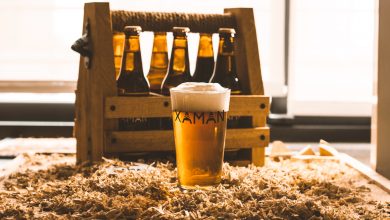Pilsner Urquell: The World’s First Pilsner Beer

Everyone loves the spice of variety. No wonder beer lovers grabbed the first opportunity to taste a new brew, deviating from the thick and cloudy ale typically served in ancient taverns. Brew lovers around the world have since been indebted to Josef Groll for spicing up their beer palates after having dark ale for so long.
Nothing would erase the name of this renowned Bavarian brewer from beer history books, even though the imitation of his invention isn’t uncommon in most breweries today. Guess what? A sizable percent of beers produced and consumed globally are proudly pale lagers, all thanks to the innovative mind of “Father of the Pilsner.”
Every beer has a story behind it. However, that of Pilsner Urquell is even more uniquely so. Do you wonder how the groundbreaking Pilsner Urquell, which means “the original source,” came to be? Well, we have the answers. Please, read on with a cup of Pilsner Urquell while we take you through the history, ingredients, processes, and festival of this remarkable draft.
How Pilsner Urquell Came to Be
In the year 1839, the Plze? locals started showing their preference for the bottom-fermented lagers imported from other regions. The Burghers of Plze? wouldn’t watch this go on without having a slice of the cake, even if it meant investing in a new and well-equipped brewery (Burghers Brewery). Hence, they employed the brain behind the brew, Josef Groll, to help compete favorably with the latest beer trend of 1839.
The Bavarian brewer wasn’t a novice when it came to the bottom-fermented beer, as he had gained enough mastery of the new recipes while practicing at his father’s brewery. Therefore, it wasn’t difficult cooking up a remarkable bottom-fermented beer recipe.
On the 11th day of November 1842, the new pale lager was first gulped by beer connoisseurs at the banquet of St. Martin fair. The launch turned out as a massive success among locals. Soon, bottles of this beer began to occupy many beer shelves around the world.
The pale lager had such notable success that some brewers named their beers Pilsner, even though such beers weren’t brewed in the region. Therefore, Pilsner Urquell was trademarked to retain the brand’s uniqueness. The iconic draft is now only brewed in the Pilsen brewery.
Also, Josef Groll ended his contract with the Pilsner brewery in 1845 and moved on to inherit his father’s beer company at Vilshofen.
The Formation of the Pilsner Urquell
The best-rated beers of the world have no affinity with mediocrity. Pilsner Urquell proved this again with its distinctive recipes, earning the affection of drinkers from different parts of the world.
Let’s help you unravel the mystery behind this golden-colored beer and its staggeringly unique taste through a thorough look at its ingredients and processes.
Soft Water
Indeed, Pilsner prides itself in its German name “original source,” as it makes sure its water ingredient is, in fact, one of a kind. The beer depends on very soft water as part of its flavor profile to satisfy beer connoisseurs with a perfectly tasting brew. Besides Burton water accounting for 1,200 parts per million (ppm), all other dissolved solids used for brewing this beer don’t exceed 50 ppm. That’s because Burton water contains sulfates, which are great enhancers of both hop and malt flavors in beers.
The brewers of Pilsner Urquell make sure to modify the pH of the soft water while mashing because it contains about 10 ppm calcium. Sulfates, hydrocarbonates, and chlorides are other primary ions present in the liquid.
Although the company relies on the city water sources to meet its water needs, it still utilizes a personal collection of Artesian wells. The location of these water sources lies less than four kilometers from the brewery. Pilsner Urquell brewery opts for the well water most of its brewing time because the water possesses a constant temperature. The Artesian well water undergoes treatment to eliminate both iron and manganese ions.

Proprietary Malt
To provide the most original type of grain, Pilsner Urquell malts its grain in the vicinity of its company and Gambrinus brewery. The annual malted grain isn’t anything less than 64,000 tons. The company admits to solely preparing its lager from a variety of barley such as the Loudis 550 barleys from Moravia. Furthermore, the grain is grown for less than six days to about 60-75 percent modification.
It’s no secret that the clarity of the Pilsner beer makes it enjoyable. This characteristic is a result of its less than eleven percent malts protein content. On the other hand, the beer’s light hue is partly as a result of its less than two percent Lovibond (°L) malt color.
So now you can tell why you have a golden color beer pouring out of a Pilsner Urquell bottle.
Triple-Decoction Mashing
Pilsner isn’t about to deviate from its longstanding tradition of beer making. To this day, the company employs its old triple-decoction style of mashing to gratify beer drinkers. This activity takes place in 170-barrel containers.
The thick parts of the pulp are extracted three times for more than 240 minutes. More so, they undergo a saccharification type of heating. After this, they experience boiling for a short while and eventually get repositioned into the principal mash container to raise the heat.
For the initial mashing, the grains are stimulated with cold water, followed by some hot water to raise the mash’s temperature to 95 degrees Fahrenheit. This decoction increases the mash temperature to about 127 degrees Fahrenheit to reduce the brew’s protein content.
Subsequently, the second decoction follows, increasing the mash temperature by 48 degrees Fahrenheit, while the last phase of the decoction raises the temperature to 163 degrees Fahrenheit.
The triple-decoction mashing modifies the mash pH in a unique manner, which the ions in the soft water can’t emulate ordinarily.
Saaz Hops
One of the distinct ingredients of the Pilsner Urquell lager is its renowned Saaz hops, which references the name of the Czech Republic town where they’re grown. The polyphenols found in the hops help preserve the beer. Notably, the beverage doesn’t undergo dry-hopping like some of its counterparts.
Furthermore, Pilsner Urquell brewery boils its wort for 120 minutes and adds three Saaz hops at 350 grams per hectoliter (g/hL) to an international bitterness unit (IBU) level of 40. The first round of hops are added to the delicious wort before it reaches the boiling point, while the second hopping takes place an hour and twenty minutes before the boiling reaches its final stage. Lastly, the third hopping requires a quarter of an hour before the boiling gets to the end.
Fermentation
Each of the 40 main fermentors contains 1,800 hectoliters of beer. The brewers pitch the 0.5 Lovibond of H-strain yeasts around 39 degrees Fahrenheit and don’t permit its temperature to go above 41 degrees Fahrenheit.
Lagering Phase
Differences abound between the old and new lagering phase of the Pilsner Urquell. The former lasts for 90 to 93 days while the latter lagering lasts for 35 to 40 days.
In the old lagering phase, brewers add the mixed beer into 25-hectoliter wooden vessels. Conversely, in the newly adopted form of lagering, brewers turn the mixed beer into 56 stainless steel vessels, which contain 3,300 hectoliters of Pilsner Urquell.
No doubt, as times change, Pilsner Urquell also upgrades its techniques.

Packaging
From the onset, Pilsner Urquell hasn’t been one to shy away from investing in state-of-the-art technology to break new grounds.
It, therefore, comes as no surprise that the company adopted a bottling line that processes 225 varieties of packaging for its lager since 2008. The improved line simplifies the packaging and helps to conserve lots of water during the bottle maintenance process. This world-standard Pilsner bottling line thus allows the company to export its beer to over 50 countries worldwide.
The Pilsner Urquell Festival
A fantastic beer unifies more than a thousand drinkers all up in one space with everyone toasting to its greatness. The Pilsner Urquell is no exception to this feat, as it engages in annual festivals right in its city of origin, Plze?, every fourth day of October.
The festival is a rare chance to behold the historical buildings of the Pilsner Urquell brewery, the origin of one of the world’s most evolutionary beer. Fans get to attend an array of memorable events, which include musical entertainment, supervised tours around the old brewery, and exciting contests.
Pilsner Urquell fans get to experience what it felt like for older lovers of the beer to savor the first-ever pale lager in the year 1842. More so, they can purchase various memorabilia of this historical beer home as a reminder of the 1842 experience.
Just in case you wish to learn how to brew this larger excellently, there’s no better place to draw a wealth of knowledge than from the Pilsner Urquell fest. Drinkers have the opportunity to watch and practice the brewing techniques of expert brewers. The festival is sure worth the trip for every Pilsner fan.
Considering the history and uniqueness of this first Pilsner beer, undoubtedly, it’ll always be prominent on any beer shelf and will never fail to amuse the many connoisseurs it caters for in at least 54 beer-savoring nations of the world.



